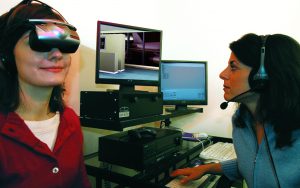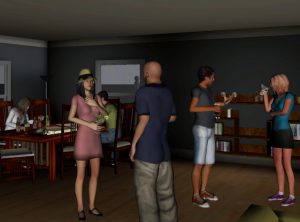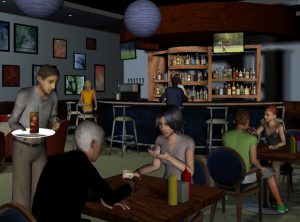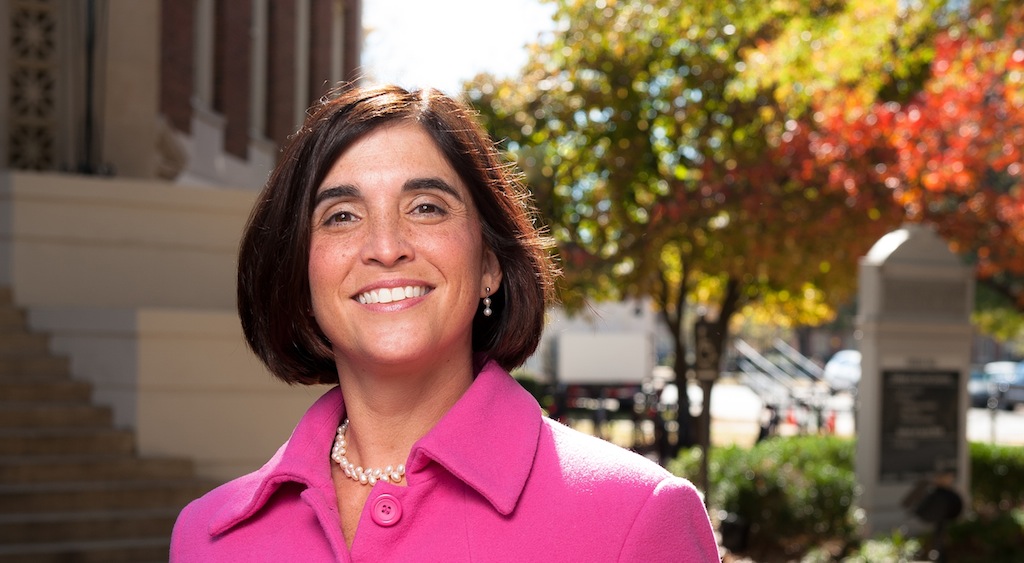
Conquering a fear of meeting new people is best achieved through social interaction. Kicking the habit of binge drinking starts with resisting the urge to pick up a bottle.
While therapists can offer role playing to help simulate the settings in which people face their fears or vices, there are missing elements that aren’t available in a therapist’s office. The sights, smells and sounds of a party, where one would often be introduced to new people or have an alcoholic beverage, can’t be simulated through one-on-one therapy.
Virtual reality, however, can fill those voids without exposing the participant to the actual environment. As a research tool, virtual reality allows researchers to expose participants to stimuli that otherwise may be dangerous, overly uncomfortable or too expensive, like a war situation or an environment where drugs are sold.
The most common application of virtual reality over the last 20 years has been in the aviation industry, where pilots have used flight simulators prior to training in real aircraft. Those settings were far easier to simulate than a social environment, where participants would interact with virtual characters, hear music and smell perfume.
The technology has advanced to where designers now use avatars instead of filmed people, create endless databases of environments, and make sounds and smells interchangeable throughout.
Additionally, virtual reality equipment and software has become increasingly affordable over the last five years.
Later this year, The University of Alabama School of Social Work is expected to install a virtual reality lab within Russell Hall. The Capstone will become the third university in the country, UA researchers say, to have a social work VR lab, joining the University of Southern California and the University of Houston.
 Since 2008, Dr. Amy Traylor has authored or co-authored nine articles on the use of virtual reality to assess cue reactivity in smokers and drinkers and in coping-skills training. Traylor hopes to use the lab for research and clinical trials, particularly with adolescents.
Since 2008, Dr. Amy Traylor has authored or co-authored nine articles on the use of virtual reality to assess cue reactivity in smokers and drinkers and in coping-skills training. Traylor hopes to use the lab for research and clinical trials, particularly with adolescents.
“VR allows for a very controlled environment,” Traylor says. “The clinician can turn it off if it gets to be too much. It can be used for developing and practicing coping skills for a variety of mental health issues, like anxiety. It’s not just for substance abuse, as it’s also used clinically for phobias.
“In terms of phobias – that’s where we’ve had the most research from a clinical standpoint – it’s generally shown to be just as effective as putting someone in the real situation,” Traylor says. “The advantage of virtual reality, then, stems from the ability to provide life-like situations for those involved in research or therapy that also ensures comfort, control, confidentiality, cost-effectiveness and safety.
“They can be assessed for certain reactions or can practice using coping skills with the assurance that, should the stimuli become overpowering, they can be removed immediately from the situation. Having that safety net may encourage more people to engage in treatment for various issues because it provides a measure of security while developing skills before being forced to use them in everyday situations.”

Traylor is pursuing an internal grant to do a focus group with girls in the Working on Womenhood program in Tuscaloosa, in conjunction with the Tuscaloosa Department of Youth Services. Many of the girls in the program have traumatic issues, and research will be conducted to see if a clinical study can be done to simulate the impulse triggers of their stress and anxiety. Additionally, information is gained from the focus groups to develop virtual environments designed to elicit stress and anxiety so the girls can practice coping skills.
Traylor has also submitted a proposal to the National Institutes of Health for a similar project with adolescents at The Bridge, an out-patient substance abuse treatment program in Tuscaloosa. In the grant, Traylor proposes to develop the environment – where they are when they smoke and who they’re with – to test children’s marijuana cravings and possibly develop coping skills.
Believability
One might question the effectiveness of virtual reality, especially before donning the helmet and wearing sensory equipment.
Adolescents, for the most part, having grown up with constantly evolving video games, could be the most skeptical. The graphics in the latest X-Box or Playstation game are far more advanced than those of simulated environments used at universities throughout the country. But, one of the nation’s leaders in producing and marketing virtual reality technology says data has proven otherwise.
“Some people say it’s not as real as video games, but, for a fear of phobias, like flying, the actual phobia causes a heightened awareness,” says Emilio Coirini, manager of business development at Virtually Better.
“It’s been pretty interesting to see people who do play games compare the way psychology was done in the past to how it’s done now with technology,” he says. “It’s basically prolonged exposure; you do this imaginable situation where you recall the traumatic event. All we’re trying to do is replace that memory with technology. It’ll be a lot better for you because there’ll be cues there to help you remember.”
The key in the technology becoming more effective and widely used is teaching doctors and clinicians to use it, Coirini says.
“Most doctors won’t do it if they’re not taught,” Coirini says. “The average doctor falls back on what they learned in school. Virtual reality makes it easier on the doctor because he or she doesn’t have to play those roles as you recall all of that.”

Most virtual reality applications, either in a social work or psychology capacity, have dealt with post-traumatic stress syndrome and addictions in adults. As a result, Traylor is anxious to incorporate adolescents into her research to weigh the effectiveness of the technology with adults versus children.
“As I got more to working with young adults and adults, we saw the older adults were fascinated with it,” Traylor said. “The younger ones? Not so much. I had a few in one study who were serious gamers, and they say it was OK. Then I’d tell them the budget was $12,000, and they’d say it’s amazing for that price. But I do worry that kids are used to stellar graphics video game companies are able to produce. We just have to try it out.”
Through her extensive work with virtual reality technology, Traylor has seen enough participants reach for a drink or say they smelled a lemon – not because a smell was simulated but because they simply saw one.
“I think there is something going on inside our brains that allow us to fill things in and make the environments more real,” she said. “For whatever reason, and this is something I’d like to research and figure out, they’re able to suspend belief just enough to feel like they’re there. There’s a feeling of presence, the feeling of being there, and so we can say the technology offers a great sense of presence.
“We’ll learn a lot here once we get going with research.”
Dr. Traylor is an assistant professor in UA’s School of Social Work.
